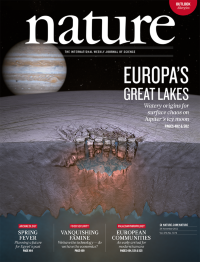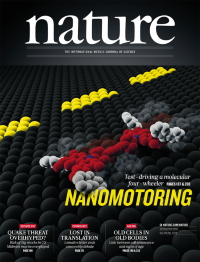Volume 479
-
No. 7374 24 November 2011
The Galileo spacecraft revealed a number of 'chaos' regions on Jupiter's moon Europa, where the surface terrain appears to have been disrupted from below. In many places, the surface contains sharp-edged blocks or rafts of ice that have at some point been flipped or rotated. Some characteristics of these regions have been hard to explain, such as the fact that the archetypal Conamara Chaos stands above its surroundings and contains matrix domes. Schmidt et al. apply lessons learned from analogous processes within Earth's subglacial volcanoes and ice shelves to an analysis of archival data that suggests chaos terrain forms above liquid water 'lenses' that are perched only 3 kilometres deep within the ice shell. The data suggest that ice–water interactions and freeze-out give rise to the varied morphology of chaos terrains, implying that more water is involved than has been previously appreciated — for instance, the sunken topography of Thera Macula, a large chaos area, may indicate that Europa is actively resurfacing over a lens comparable in volume to North America's Great Lakes. The cover depicts the lake below Thera Macula, with fractures, icebergs and matrix forming above it and disrupting the surface. Cover: Britney E. Schmidt & Deadpixel VFX/Jackson School of Geosciences/UTIG/Vetlesen Foundation/NASA.
Nature Outlook
-
No. 7373 17 November 2011
The indirect flight muscles of flying insects have evolved to power insects' wings through as many as 1,000 oscillations per second and to produce extreme mechanical forces. These exquisitely specialized muscles contain fibrillar, stretch-activated myofibres that are very different from the tubular muscles found elsewhere in the insects body. A genome-wide RNA interference screen for muscle morphogenesis in Drosophila has identified the transcription factor Spalt major (Salm) as a master regulator of fibrillar flight-muscle fate. Salm switches the structure of muscles from tubular to fibrillar during development by regulating gene transcription and splicing. The spalt gene is conserved in insects that are separated by 280 million years of evolution, and the fact that mutations in the human spalt-like gene SALL1 cause heart abnormalities in TownesBrocks syndrome suggests that spalt function might also determine fibrillar stretch-activated muscle in vertebrates. On the cover, a blow fly (Calliphora sp.) shows how its done. Image: Frank Schnorrer/Monika Krause/Väinö Haikala (MPI).
Insight
-
No. 7372 10 November 2011
Any future artificial transporters and robots operating at the nanoscale are likely to require molecules capable of directional translational movement over a surface. Even the design of such molecules is a daunting task, however, as they need to be able to use light, chemical or electrical energy to modulate their interaction with the surface in a way that generates directional motion. Kudernac et al. now unveil just such a molecule, made by attaching four rotary motor units to a central axis. Inelastic electron tunnelling induces conformational changes in the rotors and propels the molecule across a copper surface. By changing the direction of the rotary motion of individual motor units, the self-propelling molecular 'four-wheeler' structure can follow random or preferentially linear trajectories. This design provides a starting point for the exploration of more sophisticated molecular mechanical systems, perhaps with complete control over their direction of motion.
-
No. 7371 3 November 2011
This issue of Nature puts a spotlight on autism spectrum disorder and tries to sort fact from fiction in this often contentious field. Topics covered include the mysterious increase in the incidence of diagnosed autism; some of the myths that have accumulated around the condition; and the notion that, for some fields of endeavour (science is often mentioned), autism can be advantageous. Cover credit: Daren Newman.




